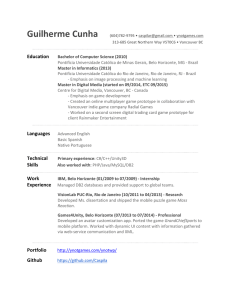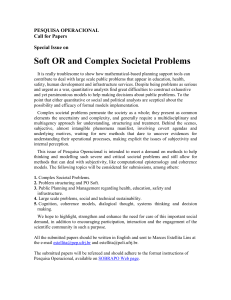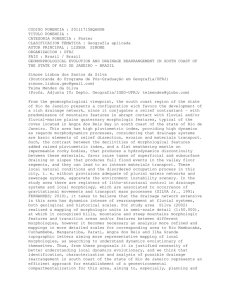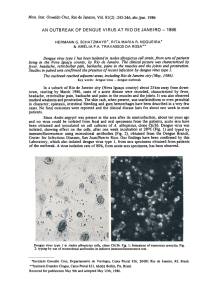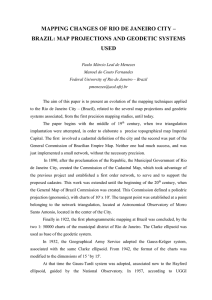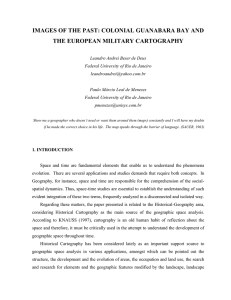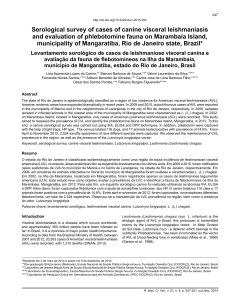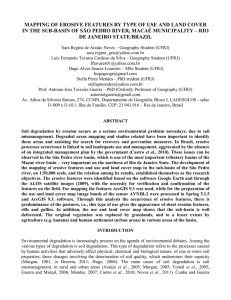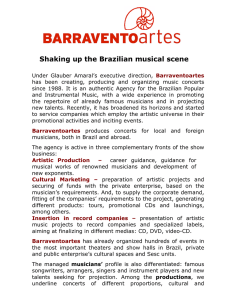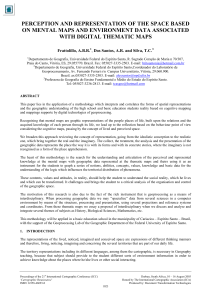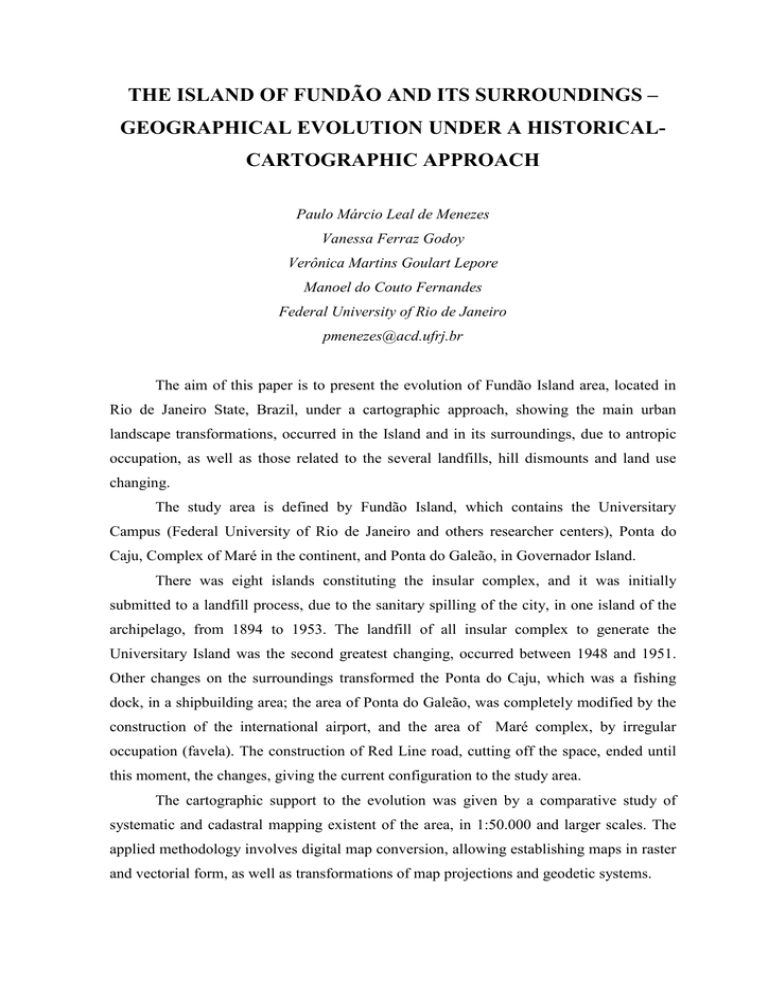
THE ISLAND OF FUNDÃO AND ITS SURROUNDINGS –
GEOGRAPHICAL EVOLUTION UNDER A HISTORICALCARTOGRAPHIC APPROACH
Paulo Márcio Leal de Menezes
Vanessa Ferraz Godoy
Verônica Martins Goulart Lepore
Manoel do Couto Fernandes
Federal University of Rio de Janeiro
[email protected]
The aim of this paper is to present the evolution of Fundão Island area, located in
Rio de Janeiro State, Brazil, under a cartographic approach, showing the main urban
landscape transformations, occurred in the Island and in its surroundings, due to antropic
occupation, as well as those related to the several landfills, hill dismounts and land use
changing.
The study area is defined by Fundão Island, which contains the Universitary
Campus (Federal University of Rio de Janeiro and others researcher centers), Ponta do
Caju, Complex of Maré in the continent, and Ponta do Galeão, in Governador Island.
There was eight islands constituting the insular complex, and it was initially
submitted to a landfill process, due to the sanitary spilling of the city, in one island of the
archipelago, from 1894 to 1953. The landfill of all insular complex to generate the
Universitary Island was the second greatest changing, occurred between 1948 and 1951.
Other changes on the surroundings transformed the Ponta do Caju, which was a fishing
dock, in a shipbuilding area; the area of Ponta do Galeão, was completely modified by the
construction of the international airport, and the area of Maré complex, by irregular
occupation (favela). The construction of Red Line road, cutting off the space, ended until
this moment, the changes, giving the current configuration to the study area.
The cartographic support to the evolution was given by a comparative study of
systematic and cadastral mapping existent of the area, in 1:50.000 and larger scales. The
applied methodology involves digital map conversion, allowing establishing maps in raster
and vectorial form, as well as transformations of map projections and geodetic systems.
It was used maps created between 1922 and 1998, and all the cartographic
information went compatible to a unique map projection, UTM, in SAD69 geodetic
system. In that way were generated maps with the visualization of the changes in each
period, as well as, the relative quantifications of landfills, coast line and associated
landscape changes.
The applied methodology of this research can be applied to other areas, such as to
Guanabara Bay coast line and municipal districts.
The maps of landscape evolution will be presented as results of the research.
1–INTRODUCTION
The Island of Fundão has in current days a great importance to the city of Rio de
Janeiro. On one side it has an expressive part of the Federal University of Rio de Janeiro,
with the Centers of Technology, Letters, Arts, Mathematics and Nature, as well as Health.
Others Research Centers , CENPES of PETROBRAS, in expansion at this moment, as well
as of ELETROBRAS, NUCLEBRAS and Mineralogy, defining a pole of high technology
to the country. The integration of the research centers with the University is accomplished
in practically all knowledge areas.
Its surrounds is represented by the continental areas, defined for the Complexo da
Maré and Ponta do Caju, Ilha do Governador and Guanabara Bay around it, all of them
important for the geographical evolution study. The landscape changing are expressive,
characterizing, mainly starting from the end of the first quartile of the 20th century, violent
changes not only on landscape, but also on environment and in the evolution of the
antropic occupation, promoting disordered occupations (favela processes), which
influences enough the whole study area.
The aim of this paper is present the study of the evolution of the area, through a
vision obtained by the cartography of the area. The study period will be between 1930 and
2004, however it will be presented some previous facts, which also had influences in its
evolution.
1.1 Study Area
The area to be studied will be framed by the established coordinates by the table 1
Table 1–Framing of study area
Point E (UTM)
N (UTM) Latitude
Longitud
1
678000
7468000
-22o 53’ 10.9” -43o 15’ 53.1”
2
678000
7476000
-22o 48’ 50.9” -43o 15’ 56.4”
3
686000
7476000
-22o 48’ 47.8” -43o 11’ 15.9”
4
686000
7468000
-22o 53’ 07.8” -43o 11’ 12.4”
This area includes the four described areas, which will be object of the evolutionary
study: Ponta do Galeão, Complexo da Maré, Ilha Universitária and Ponta do Caju. Figure
1, presents the areas.
Figure 1 – Location of the study areas–Source IPP–Grocery store of Data
The area includes the following neighborhoods of Rio de Janeiro: Cidade
Universitária, Caju, Galeão (a small area) and Maré. Some spaces from the neighborhoods
of Penha, Ramos, Olaria and Bonsucesso will be approached by the research. Relating to
administrative areas, the research embraces to Porto I, XX Ilha do Governador, XXX
Maré, X Ramos and XI Penha.
1.2 – Some History
The study area comes as one of the largest transformations areas, due to the several
landfills, occupations and some dismounts. But mainly due to the landfills, the
environment was quite changed, characterizing in some places impacts and degradations
that affect not only local influence, but alsohaving a wide influence area.
The area of the Ilha Universitária was constituted by eight small islands Fundão,
Baiacú, Cabrasts, Pindaí do Ferreira, Pindaí do França, Catalão, Bom Jesus and Sapucaia,,
which, between 1949 and 1952, were land filled and interlinked, totaling a surface of 5,9
million square meters. In 1953, the resulting island of the coalition of the eight islands
archipelago was named as Island of the Academical City of University of Brazil. Part of
the landfill was done with a disassembling of an hill in the Island of Fundão and sand
dredged of the bottom of the bay. Bom Jesus' Island, the biggest had some buildings,
having sheltered the Church of Bom Jesus of the Column, built in 1703. Later it had a
convent, transformed in one Asylum of the Disable persons of the Paraguay War and a
Military Prison.
This was not the first impact on the study area. The Island of Sapucaia was used,
since the 19th century, as garbage collector of the city. In 1876, an origin French, Aleixo
Gary signed a contract for collection and garbage deposit, in Island of Sapucaia, that lasted
long up to 1891. In 1892 the company was extinguished, however the collection and
deposit was lasted long until the decade of 1950. It was still incorporate garbage landfills
in Ponta do Caju. The importance of the Garys for the urban cleaning of Rio de Janeiro,
was such that the employees who worked with the garbage had, ever since, the name of
garis, term also employed in other Brazilian cities.
The Ponta do Caju, in turn, beyond also having being a garbage landfill, had been
seing later, 1948-1953 and 1962-63 entirely disfigured by successive landfills, that had
joined the Island of Pinheiros to the continent and having created a naval industrial
complex, with some installed shipyards.
Ponta do Galeão had also landfills, so to receive the International Airport of Rio de
Janeiro (Galeão). Some transformations have occurred, and the last ones were done when
Red Line Road was constructed, in 1992.
The area of Maré had also big landfills, which had increased environmental
problems. Initiating in the Saco da Gamboa, for the modernization and rectification of the
Port of Rio, in 1905, all the mouth of the rivers Faria-Timbó was landfilled. Some
lowlands which still existed in 1975, was landfilled. Pinheiros Island was joint to the
continent. Two great landfill occurred, one in 1992, to Red Line Road construction and
in 2003 with linking of Red and Yellow Lines Road to the Ilha Universitária.
2 - CARTOGRAPHY OF THE AREA
Few were the maps which previously to the century XX allowed the observation of
the studying area in bigger details. The great majority of the maps present the set of
schematical form, many times not even showing its localization.
The “Plain of la Baye et du Port de Rio Janeiro”, of 1751, shows with reasonable
precision the Island of Bom Jesus (Frade or Hospício), well dislocated Sapucaia and
Pinheiros, but it does not present the Islands of the Fundão and Cabras. The Ponta do Caju
and the Island of Governador are presented with some deformations.
From the first quartile of century XIX, all the set is represented in sufficiently
necessary form. It is possible to distinguish with reasonable precision the original size of
the Island of Sapucaia and after 1905, its size, already with the load of the landfill of the
garbage of the city.
The Cartography through photogrammetric processes, was only initiated with the
Letter 1:50 000 of 1922. Previously only the topographical letters were carried through by
the City hall of the Federal District. The mappings of 1935, 1957 and 1984 are also
available, carried through in the scale 1:50 000.
Effectively, an expressive mapping will only occur in 1975, with the
accomplishment of the mapping of the Metropolitan Region, in 1:10 000. After this
mapping, only in 1994, 1999 and in 2004, Rio de Janeiro was mapped with the execution
of orthophotos and vectorial digital maps.
In relation to the projective systems, only with the 1922 mapping, the association to
a polyhedral system is established. This system is characterized by a gnomonic projection,
whose projection center was defined in the Astronomical Observatory of Morro of Santo
Antonio (Observatório do Morro de Santo Antônio), on 1880 Clarke ellipsoid.
This ellipsoid served to the 1935 mapping, with the adoption of Gauss-Krüger
Conformal Projection System In 1942, was adopted Gauss-Tardi system but it was used
Hayford ellipsoid. In 1957, the Universal Transverse Mercator map projection was
adopted, and Córrego Alegre geodetic system. The same system was adopted later with
SAD-69 geodetic system. Currently, there has been having transformation for the SIRGAS
2000 geodetic system.
3 – METODOLOGY
3.1 – Analogical Digital Documents Transformation
All analogical maps are rasterized in a 300 dpi resolution, to a graphical file in tif
format. The raster is submitted to color correction, equalization and electronical repair, if
needed.
3.2 –Raster Maps
They are only submitted to the last steps of last process.
3.3 – Raster-Vector Transformation
All raster maps are vectorized following this steps::
- Raster attached to a vector program, in a local coordinate system (0,0);
- Defining vectorization on several layers. These layers are the same of database, such as
coast line, hidrography, roads, streets and so on.
- Correction, cleaning and validation of the map;
- Topology creation;
- Georreferencing process;.
- Compatibilization of projections and geodetic systems;
- Transformation to project scale;
Use of satellite images medium and high resolution to update some database data,
such as land use.
3.4 – Spatial Analyses
Development of spatial analyses over the area. Estão previstas as seguintes análises:
- Urban evolution landscape;
- Phisycal landscape evolution; Both geographically and on time.
- Digital elevation model development, with batimetry and altimetry;
Other needed to complementary studies.
4 – CONCLUSIONS
All maps are digitized, and all are transformed to SAD 69 UTM system.
The cartographic support to the evolution was given by a comparative study of
systematic and cadastral mapping existent of the area, in 1:50.000 and larger scales. The
applied methodology involves digital map conversion, allowing establishing maps in raster
and vectorial form, as well as transformations of map projections and geodetic systems.
It was used maps created between 1922 and 1998, and all the cartographic
information went compatible to a unique map projection, UTM, in SAD69 geodetic
system. In that way were generated maps with the visualization of the changes in each
period, as well as, the relative quantifications of landfills, coast line and associated
landscape changes.
The applied methodology of this research can be applied to other areas, such as to
Guanabara Bay coast line and municipal districts.
The maps of landscape evolution will be presented as results of the research.
Some high resolution images will be added to DEM images, as well as to show a
model close to reality..
5 – BIBLIOGRAPHY
ABREU, M. de A., A Evolução Urbana do Rio de Janeiro, Rio de Janeiro, IPLANRIO,
1987
CENTRO DE ARQUITETURA E URBANISMO DO RIO DE JANEIRO, Do
Cosmógrafo ao Satélite: Mapas da Cidade do Rio de Janeiro, UFRJ, FUJB, 2000
ETUB – Escritório Técnico da Universidade do Brasil) – Relatório Técnico, 1952
ETUB – Escritório Técnico da Universidade do Brasil) – Relatório Técnico, 1953
FUNDREM, Fundação do Desenvolvimento da Região Metropolitana, Mapeamento 1: 10
000, 1975
IPP, Instituto Pereira Passos, Mapeamento Cadastral do Rio de Janeiro, 1998
LAMEGO, A. R., O Homem e a Guanabara, IBGE – Conselho Nacional de Geografia,
1964
MARBLE, D. F., The Computer and Cartography, The American Cartographer, 14, 101103. 1987.
MENEZES, P. M. L., Notas de Aula de Cartografia e Cartografia Temática, Não
publicadas, Curso de Graduação em Geografia, Dep de Geografia, UFRJ, Rio de
Janeiro, RJ. 1996.
MENEZES, P. M. L., Notas de Aula de Cartografia Temática, Não publicadas, Curso de
Graduação em Geografia, Dep de Geografia, UFRJ, Rio de Janeiro, RJ. 1996.
MENEZES,P. M. L. Aquisição, Tratamento e Armazenamento de Cartas Topográficas
Digitalizadas, Tese de Mestrado, IME, RJ. 155 pp. 1987.
MENEZES, P. M. L., A Interface Cartografia-Geoecologia nos Estudos Diagnósticos e
Prognósticos da Paisagem: Um Modelo de Avaliação de Procedimentos AnalíticoIntegrativos. Orientadora: Ana Luiza Coelho Neto. Rio de Janeiro: UFRJ/ PósGraduação em Geografia, 2000. 271p. Tese de Doutorado
VILARINHOS, M. L. R. ,O Campus da UFRJ na Ilha do Fundão: Análise Espacial de Sua
Localização e Organização Espacial, Orientadora Profa Dra Iná Elias de Castro.
Rio de Janeiro, UFRJ/ Programa de Pós-Graduação em Geografia, 2000. 97 p,
Dissertação de Mestrado
OLIVEIRA, C., Dicionário Cartográfico, IBGE, Rio de Janeiro, RJ. 1980.
PETERSON, M. P. Interactive and Animated Cartography, Prentice Hall, NY, 464 pp,
1995.
ROBINSON, A. H., MORRISON, J. L., MUEHRCKE, P. C., KIMERLING, A. J. and
GUPTILL, S. C., Elements of Cartography – 6th Ed, 544 pp, New York, John
Willey & Sons. 1995.
SARTHOU, C., Passado e Presente da Baía de Guanabara, Livraria Freitas Bastos S.ª, Rio
de Janeiro, 1964
VIANNA, C. R., Generalização Cartográfica em Ambiente Digital Escala 1:250 000 a
Partir de Dados Cartográficos Digitais na Escala 1: 50 000, Tese de Mestrado, IME,
Rio de Janeiro. 1997.

